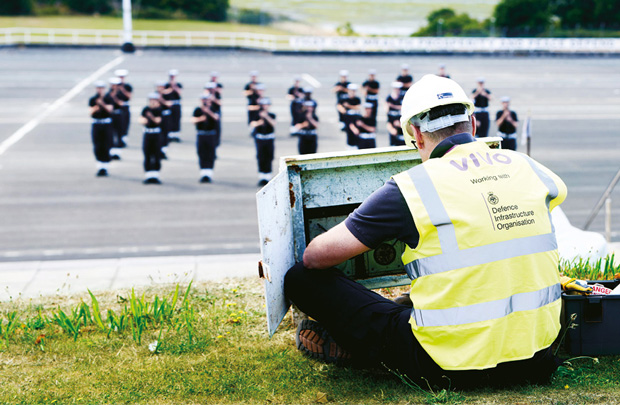 David Brewer, Chief Operating Officer, MOD’s Defence Infrastructure Organisation brings Sara Bean up to date on how the first of the Defence Infrastructure Organisation’s £1.6 billion Built Estate contracts is driving improvements
David Brewer, Chief Operating Officer, MOD’s Defence Infrastructure Organisation brings Sara Bean up to date on how the first of the Defence Infrastructure Organisation’s £1.6 billion Built Estate contracts is driving improvements
The Defence Infrastructure Organisation (DIO), which is responsible for maintaining Ministry of Defence (MOD) infrastructure, including military housing, training and construction has been working hard in recent years to improve the services it delivers to its Armed Forces customers. Speaking to FMJ back in 2020, David Brewer, Chief Operating Officer of MOD’s Defence Infrastructure Organisation outlined plans to overhaul services, digitise processes and build stronger relationships with suppliers.
By April 2022 the first phase of the Future Defence Infrastructure Services (FDIS) programme was underway, which reimagines the delivery of crucial building maintenance and hard facilities repair services across the UK defence estate.
Four new regional contracts worth £1.6 billion; went to Mitie, which manages facilities across Scotland and Northern Ireland; VINCI in the South East of England and VIVO (a joint venture between Serco and Equans), covering the central region of the UK including Wales, the Midlands, the North of England and the South West. The contracts are for an initial seven years, with the option of a further three-year extension.
After crossing the one-year milestone, Brewer reflected on the scale of the challenge.
“It’s important to recognise the size, diversity and nature of the Defence Estate. There are 133,000 buildings across the whole of the UK, which range from private houses to bomb proof nuclear bunkers, to high tech surveillance facilities and everything in between. There are thousands of SSSIs, (Sites of Special Scientific Interest) and historic listed buildings, so that level of diversity is an incredibly important bit of context.
“You’ve the other challenge of several different generations of facilities built to different standards at different times and the fact that because of affordability issues, at times the estate has not been kept up to date and maintained in a way we would like and ended up in a situation where a lot of it is in pretty poor condition. You’re then trying to make that whole thing work as a collective piece, which really asks a lot of your maintenance activity.
“The challenge is how do you make sure you’re looking after that type of infrastructure in a way that it is doing the job it needs to do for its users who are themselves doing pretty important jobs? This also includes residential accommodation for personnel and their families.”
PROCUREMENT PROCESS
The procurement process began with a review of the estate’s assets and an assessment of how well they were performing. The complex audit put the DIO in a position to deliver an improved and proactive repair service which over the life of the programme would ensure that properties were being more actively maintained.
When it came to the successful bidders, says Brewer: “What we were looking for as a differentiator was ‘What is this organisation going to be like to work with in the long term? Do they share our values? Do they care about the job the defence estate does for our military people, the operational capability and the lived experience? And are they up for working with us to continually improve throughout the life of the contact? We’ve all seen good bids that aren’t followed through.
“We had to build in more capacity so we’ve been building and upscaling our team, simplifying our processes and procedures and obviously putting these new set of relationships in place with our suppliers. All of those things were an important element of building a capability that was going to be fit for the future.
“We were also really keen that those partners were going to work as a community rather than feeling like they were competing with each other.”
ONE TEAM APPROACH
Core to the FDIS programme was the establishment of a closer relationship with suppliers based on openness, honesty and trust. This saw the creation of a ‘Supplier’s Alliance’ which allows VINCI, VIVO and Mitie to share knowledge and ideas. To aid this process, the suppliers have established joint working groups on management, on maintenance schedules, project delivery and on health, safety and environment where all of the teams and the suppliers come together and share ideas.
This for example has enabled better planning for building maintenance work, with a joint review concluding that changing a practice of carrying out maintenance every week to once a fortnight could free up resources for other projects.
“Historically, suppliers were often unwilling to talk and share best practice about health and safety,” explains Brewer, “so we were trying to get to that position where they realised it’s in their best interests to share information to be successful, by creating a culture of ‘we succeed or we fail as a collective’.”
A crucial part of this ‘one team’ approach is the alignment of the DIO’s database with its suppliers. The system is designed to hold accurate data about every asset on the defence estate, to enable the shift towards a more preventative maintenance approach.
Says Brewer: “We’ve got a real time exchange of information which shows assets we’ve got, what’s failed, what’s working, what work is being done and how long it was off line. We’re working with the suppliers to increase the detail of that and build a full register which allows us to collectively exploit the intelligence that’s now held within our asset system.”
“As the client organisation we have been quite prescriptive in terms of what information we want captured and have a common asset hierarchy so that we and all of the suppliers are holding information in the same format and describing things the same way. That means for an estate of this scale and complexity we’ve come to a point where we’ve a really good understanding of what our assets are and the tough bit now is how to exploit that information to make better decisions.”
Tagged with: David Brewer Defence Infrastructure Organisation (DIO) DIO Built Estate Contracts Future Defence Infrastructure Services (FDIS) programme Ministry of Defence






